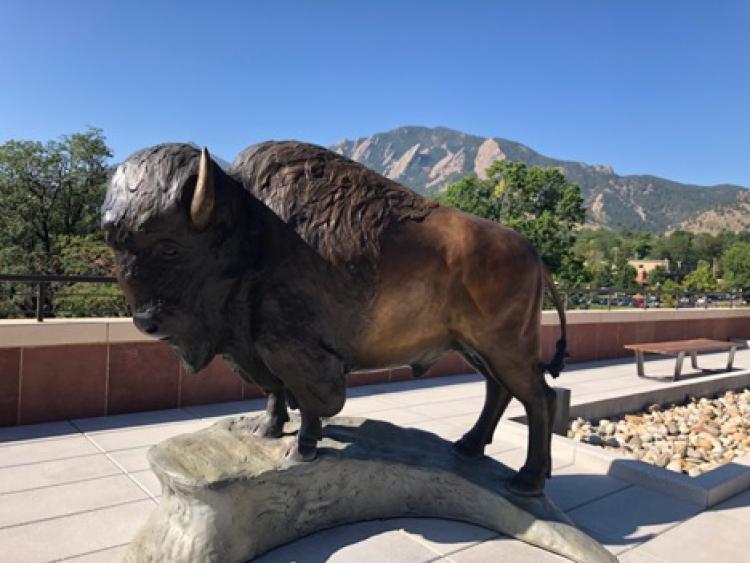Campus Q&A: A new dean's take on University Libraries and the campus
CU Boulder Today sat down with one of the campus's newest deans, Robert McDonald, who discusses his perspectives on everything from the libraries' greatest assets in service to the community to a favorite spot on campus, which has a stellar view of the Flatirons.
What does the work of a dean of libraries entail?
Like any large organization at a university, a dean’s work is both internal and external. I serve as the Libraries’ representative to the university, to both academic and administrative units, to other university groups such as student and faculty organizations, within the larger community of academic libraries nationally and globally, and of course to CU alumni, friends and donors.
Together my Libraries’ colleagues and I constantly strive to provide the best possible services and collections via our website and our five campus locations: the William M. White Business Library, the Jerry Crail Johnson Earth Sciences & Map Library, the Leonard H. Gemmill Engineering, the Mathematics & Physics Library, the Howard B. Waltz Music Library, and last but not least, Norlin Library, named for our former president George Norlin.
Previously, at Indiana University, you had a role focused on research technologies. Are you bringing that with you to CU Boulder? What will some of your other focal points be?
Thanks for asking—that’s a great question. My background in technology and innovation (research computing and learning technologies) will now drive my work in new and different ways. In the past I have worked closely with the HathiTrust Digital Library and the HathiTrust Research Center, and as the CU Boulder Libraries are new members of this organization, I fully expect our campus to make use of this unique digital collection.
I will also aim to bring my previous leadership experience in higher education to bear as I work with all of the Libraries’ faculty and staff in furthering our mission as a dynamic partner in creating, disseminating and advancing scholarship.
In the history of University Libraries, is there anything that stands out to you as a foundational moment, setting a certain course for the massive resource and its community, or that stands out to you as unique among peer institutions?
Among peer institutions, our archives and special collections are very unique and represent our region really well in terms of CU history, Colorado history and Boulder community history, having been molded by the researchers and librarians who have worked at CU over our 142 year history. These collections represent a wealth of information from the earliest works of Galileo, to the correspondence of William Duane (Duane Physics building) to his celebrated colleague Marie Curie, and from a truly stellar children’s book collection to the pamphlets of the early UMAS student organization. These are in addition to the over 7.5 million volumes of print and digital works that we have in support of the teaching and research mission of the university.
What do you think is University Libraries' greatest asset?
This is an easy question. While our collections are important, our most treasured asset is our people—the many librarians and staff who spend their life's work in helping to build our collections, make the collections more readily available to all who need them, and support students and researchers at all levels as they make use of the materials.
What do you hope for University Libraries and the CU Boulder community?
I think we have some wonderful initiatives happening on campus right now. From Academic Futures to the Diversity, Inclusion and Academic Excellence Plan to the Campus Strategic Facilities Visioning plan, we are seeing major changes across our campus, and I hope the University Libraries can truly be a substantive partner with the CU Boulder community in enabling and implementing many of the great ideas from these community efforts.
Additionally, I would like to see all of our cultural heritage organizations on campus work toward deeper collaboration in all of our service areas. One great example of this is the new field guide (PDF) for cultural events that helps students identify great art and science events across campus.
What are some of the ways in which University Libraries serves students and the campus community beyond loaning books?
Following on the idea that our staff are our greatest asset, some of our most valuable services are those that connect the expertise of the Libraries’ staff and faculty with CU faculty, staff and researchers. A variety of consulting services happen in our libraries every day, including research consultations at all levels, data management consultations, digital scholarship consultations, instruction for individual classes in areas of information literacy and research methods, as well as co-curricular workshops on methods and emerging tools.

Have you discovered a favorite place on campus?
This might be the hardest question yet! I love all of our libraries, as well as the other cultural heritage organizations on campus such as the natural history museum, the art museum, the Fiske planetarium and the Heritage Center.
To name just one place, though: I have recently discovered the wonderful view from the upper balcony of the new CASE building (and there’s a buffalo sculpture). I have to say, this view of the Flatirons is not to be missed.


